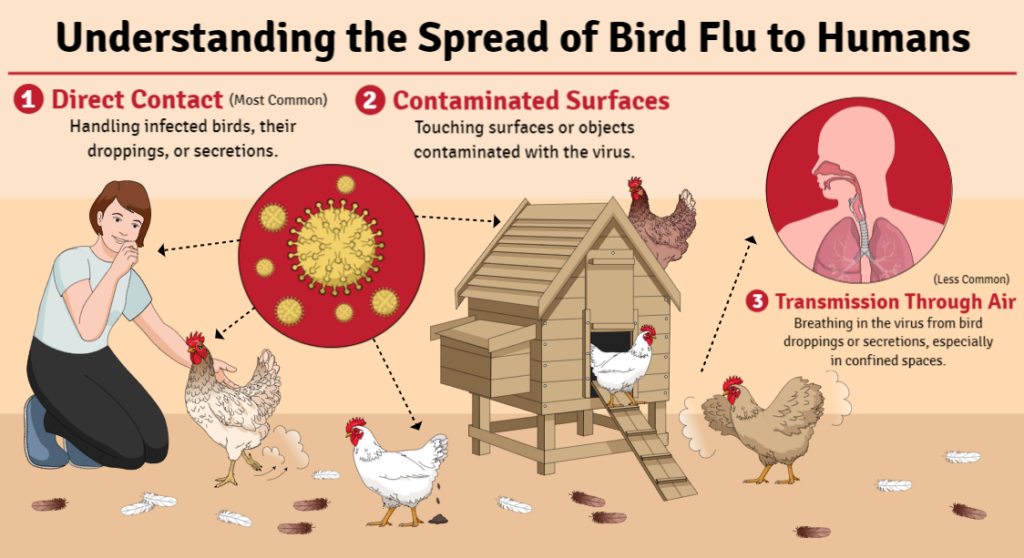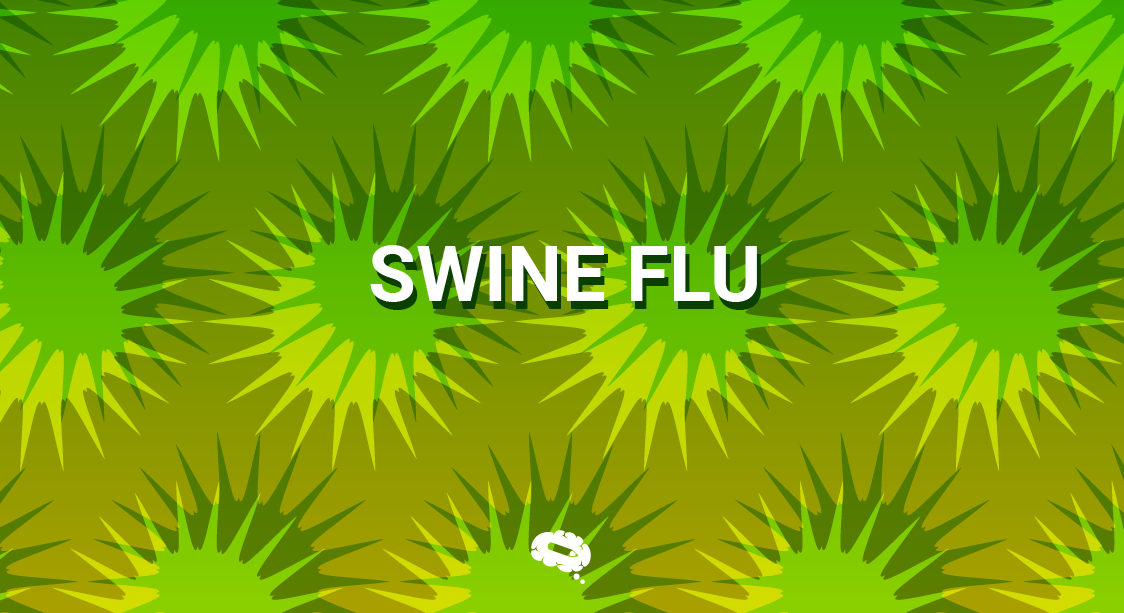Bird flu, or avian influenza, is a viral disease primarily affecting birds but with the potential to infect humans, leading to serious health risks. Caused by strains of the influenza A virus, such as H5N1, bird flu can spread rapidly among poultry, resulting in significant economic losses and disruptions to the global food supply. Understanding bird flu is crucial not only for those in the poultry industry but also for the general public, as early detection and awareness can prevent the spread of the virus to humans. Effective knowledge and preparedness are essential for managing outbreaks and reducing their health and economic impacts. In this article, we will explore the nature of bird flu, its global impact, and the importance of staying informed and prepared to safeguard public health and economic stability.
What is Bird Flu?
Bird flu, or avian influenza, is a viral infection that primarily affects birds but can sometimes spread to humans and other animals. Caused by the influenza A virus, bird flu manifests in birds with symptoms ranging from mild respiratory issues to severe disease and death. The virus is highly contagious among avian species, leading to significant outbreaks in poultry populations. For more information, visit the World Organisation for Animal Health (WOAH) and the Centers for Disease Control and Prevention (CDC).
Common Strains of Bird Flu:
H5N1: Identified in 1997, H5N1 is a highly dangerous avian influenza strain causing severe outbreaks in poultry and wild birds, with a high mortality rate in humans.
H7N9: Emerging in 2013, H7N9 has caused significant outbreaks in China, affecting both birds and humans with severe respiratory illness and major economic impacts on the poultry industry.
H5N8: First identified in 2014, H5N8 has caused outbreaks in Europe, Asia, and Africa, primarily affecting birds but raising concerns due to its rapid spread.
H9N2: A low-pathogenic strain circulating globally for decades, H9N2 is less virulent but has occasionally infected humans, prompting ongoing surveillance.
How Bird Flu Spreads
Transmission
Bird flu primarily spreads among birds through direct contact with infected avian species, their droppings, or contaminated environments. The virus can also spread via airborne droplets, particularly in crowded poultry farms or areas with poor sanitation. Wild birds, especially waterfowl, are natural reservoirs of avian influenza and can transmit the virus to domestic poultry during migration.
Transmission to humans, though less common, typically occurs through close contact with infected birds or their secretions, such as during handling or slaughtering. The virus can also spread via contaminated surfaces or environments, posing a risk in areas with poor biosecurity measures. While human cases are rare, they can result in severe respiratory illness, making it crucial to manage and control the spread of the virus in avian populations to protect public health.

Risk Factors
Environments at High Risk:
Poultry Farms: Enclosed or densely populated farms are highly vulnerable due to high bird concentrations and the potential for rapid virus spread, exacerbated by poor ventilation and sanitation.
Live Bird Markets: These markets, with high bird density and inadequate hygiene, facilitate the spread of avian influenza.
Wetlands and Waterfowl Habitats: Natural reservoirs like lakes and wetlands, frequented by wild waterfowl, help spread the virus among wild and domestic birds.
Backyard Poultry Operations: Small-scale farms with less stringent biosecurity measures are at higher risk, especially if they interact with wild birds.
Occupations at High Risk:
Poultry Workers: Those handling, caring for, and slaughtering poultry are at higher risk due to close contact with potentially infected birds.
Veterinarians: Vets working with birds, especially in outbreak areas, may be exposed through direct contact with sick or deceased birds.
Poultry Market Workers: Employees in live bird markets, handling and selling birds, face increased risk from frequent close contact with live poultry.
Wildlife Researchers and Bird Banders: Professionals studying or handling wild birds in outbreak areas may be exposed to avian influenza viruses.
Symptoms of Bird Flu
Common Symptoms in Birds
Respiratory Issues: Infected birds often exhibit symptoms such as coughing, sneezing, nasal discharge, and labored breathing. These respiratory problems can be severe and lead to increased mortality.
Digestive Problems: Diarrhea and other gastrointestinal disturbances may occur, leading to dehydration and weakness in affected birds.
Neurological Signs: Some strains of avian influenza can cause neurological symptoms, including tremors, uncoordinated movements, and a twisted neck (torticollis).
Decreased Egg Production: Laying hens may experience a drop in egg production, with eggs appearing misshapen or having soft shells.
Swelling and Cyanosis: Swelling of the head, comb, and wattles, and a bluish discoloration of the comb and wattles (cyanosis), can be observed in severe cases.
Sudden Death: In some cases, birds may die suddenly without showing overt signs of illness, especially with highly pathogenic strains.
How It Affects Bird Populations:
High Mortality Rates: Avian influenza can lead to high mortality rates among infected bird populations, significantly reducing flock sizes and causing economic losses for poultry producers.
Disruption of Breeding: Decreased egg production and reproductive issues can impact breeding success, leading to long-term population declines in affected areas.
Displacement of Species: Infected birds may abandon their nests or feeding grounds, leading to disruptions in local ecosystems and affecting the balance of species in their habitat.
Economic Impact: The need to cull infected and potentially exposed birds to control the spread of the virus results in economic losses for poultry industries and can affect the availability and cost of poultry products.
Common Symptoms in Humans
Respiratory Symptoms: Similar to seasonal flu, bird flu can cause fever, cough, sore throat, and shortness of breath. These symptoms may start suddenly and can be severe.
Muscle Aches and Fatigue: Infected individuals often experience muscle aches, joint pain, and extreme fatigue, which can be debilitating.
Headaches and Fever: High fever and severe headaches are common, with temperatures often reaching 102°F (38.9°C) or higher.
Chills and Sweats: Patients may experience chills, sweating, and overall discomfort, which can exacerbate the feeling of illness.
Gastrointestinal Symptoms: Some strains can cause nausea, vomiting, and diarrhea, though these are less common compared to respiratory symptoms.
Complications That May Arise:
Pneumonia: Bird flu can lead to severe pneumonia, characterized by inflammation and fluid accumulation in the lungs. This complication can be life-threatening and may require hospitalization.
Acute Respiratory Distress Syndrome (ARDS): A severe condition where the lungs cannot provide enough oxygen to the blood, ARDS can develop from bird flu, leading to difficulty breathing and requiring intensive care.
Organ Failure: In severe cases, bird flu can cause multi-organ failure, affecting organs such as the liver, kidneys, and heart, which can be fatal.
Secondary Infections: The weakened immune system due to bird flu can make individuals more susceptible to secondary bacterial infections, such as bacterial pneumonia.
Sepsis: A serious and potentially life-threatening complication, sepsis occurs when the body’s response to infection leads to widespread inflammation and organ dysfunction.
Neurological Complications: Although rare, severe cases of avian influenza can lead to neurological symptoms such as confusion, seizures, and other signs of brain inflammation.
Preventing Bird Flu
Hand Washing: Frequently wash hands with soap and water, especially after handling birds or cleaning their habitats.
Disinfection: Use disinfectants to clean surfaces, equipment, and environments where birds are kept to reduce the risk of virus transmission.
Protective Gear: Wear protective clothing, such as gloves and masks, when handling birds or working in environments with potential exposure to avian influenza.
Stay Away from Sick Birds: Avoid direct contact with birds that appear sick or are found dead. Report any unusual bird deaths to local health authorities.
Biosecurity Measures: Implement strict biosecurity protocols in poultry farms, including controlling access, ensuring clean facilities, and monitoring bird health regularly.
Avoid Live Bird Markets: Steer clear of live bird markets and areas with high
Importance of Vaccination:
Disease Control: Vaccination is a key tool in controlling avian influenza outbreaks by reducing the incidence of the disease in poultry populations. This helps prevent the spread of the virus and mitigates the risk of transmission to humans.
Economic Protection: By minimizing disease outbreaks, vaccination helps protect the poultry industry from significant economic losses due to culling and trade restrictions.
Public Health Safety: Effective vaccination in poultry can lower the risk of avian influenza strains evolving and spreading to humans, contributing to overall public health safety.
Availability of Vaccines:
Poultry Vaccines: Several vaccines are available for poultry, targeting specific strains such as H5N1 and H7N9. These vaccines are used in high-risk areas and in poultry with a history of avian influenza outbreaks.
Development and Distribution: Vaccine availability can vary by region and is dependent on the development of effective vaccines for specific strains. Governments and international organizations often collaborate to ensure vaccines are available and accessible in areas with significant outbreaks.
Ongoing Research: Continued research and development are crucial for improving existing vaccines and creating new ones to address emerging strains of avian influenza and enhance overall vaccine efficacy.
Read more about next-Generation Vaccines in the article: Next-Generation Vaccines: A New Frontier in Disease Control
Treating Bird Flu
Medical Treatment
Antiviral Medications: Some antiviral drugs are used to treat bird flu, particularly when started early. They work by inhibiting virus replication, thus reducing symptom severity and duration. For best results, these medications should be administered within 48 hours of symptom onset, especially for severe cases or high-risk individuals.
Hospital Care for Severe Cases: Severe bird flu cases may require hospitalization, where supportive treatments such as oxygen therapy, intravenous fluids, and symptom management are provided. Mechanical ventilation might be necessary for respiratory failure, and patients are monitored for secondary infections and multi-organ complications. Timely and comprehensive hospital care is essential for improving survival and managing the disease’s impact.
Home Care
Managing Mild Symptoms at Home: For mild bird flu symptoms, rest, hydration, and over-the-counter medications can aid recovery. Good hygiene practices, like frequent hand washing and using tissues, help prevent the virus’s spread. Isolate from others until symptoms improve.
When to Seek Medical Attention: Seek medical care if symptoms worsen or if severe signs such as difficulty breathing, persistent high fever, chest pain, confusion, or severe weakness occur. High-risk individuals should consult a healthcare provider early to avoid complications.
Impact of Bird Flu
On the Poultry Industry: Bird flu significantly impacts the poultry industry, causing economic losses due to the culling of millions of birds and disrupting trade with export restrictions. In response, the industry implements enhanced biosecurity measures, improved hygiene, restricted access, and vaccination programs, alongside investments in rapid response and surveillance to stabilize and protect against future outbreaks.
On Public Health: Bird flu affects public health by prompting vigorous monitoring and response efforts. Authorities employ enhanced surveillance, public awareness, and vaccination for high-risk groups to manage potential human infections. The risk of avian flu evolving to spread easily among humans raises global health concerns, leading to increased international collaboration, research, and preparedness to mitigate future public health threats.
Online Scientific Design Tool For Your Classes, Speeches, Papers, And Much More
Mind the Graph is an innovative online platform to help scientists, researchers, and educators create visually compelling and accurate scientific illustrations. This tool simplifies the process of designing graphics for a variety of scientific purposes, including classes, presentations, research papers, and other forms of communication. Mind the Graph enables users to convey complex concepts clearly and effectively by offering a vast library of scientifically accurate illustrations and customizable templates. The platform’s intuitive interface allows users to design professional-quality visuals, enhancing the impact of their work and making scientific information more accessible to diverse audiences. Whether for educational purposes or professional presentations, Mind the Graph provides the resources scientists need to elevate their visual communication. Sign up for free now!

Subscribe to our newsletter
Exclusive high quality content about effective visual
communication in science.








